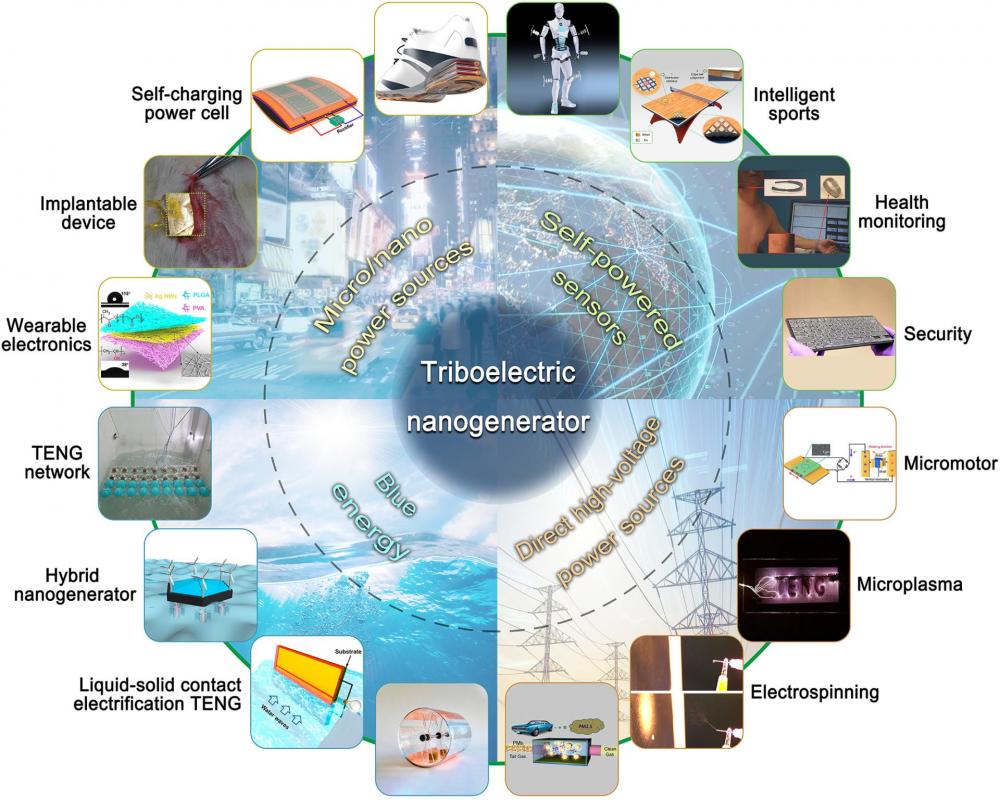R.E.News future Technology-Sticky Surfaces Are Sparking a New Era of Energy Generation
 06/02/25-FR-English-NL-footer
06/02/25-FR-English-NL-footer
Les surfaces collantes ouvrent une nouvelle ère de production d’énergie
 Image- American Chemical Society
Image- American Chemical Society
Dans le paysage en constante évolution de l’énergie durable, les chercheurs recherchent en permanence des méthodes innovantes pour exploiter l’énergie des matériaux du quotidien.
Une percée récente concerne l’utilisation de ruban adhésif ordinaire pour générer de l’électricité, offrant une approche rentable et efficace de la récupération d’énergie.
Au cœur de cette innovation se trouve le nanogénérateur triboélectrique (TENG), un dispositif qui convertit l’énergie mécanique en énergie électrique grâce à l’effet triboélectrique, c’est-à-dire essentiellement de l’électricité statique. Les TENG traditionnels reposent souvent sur des matériaux spécialisés et coûteux, mais une équipe de l’American Chemical Society dirigée par Gang Wang et Moon-Hyung Jang a démontré que des objets du quotidien comme du ruban adhésif, du plastique et de l’aluminium achetés en magasin peuvent être utilisés pour créer un TENG efficace et peu coûteux.
Dans leur conception initiale, les chercheurs ont empilé des couches de ruban adhésif double face, de film plastique et d’aluminium. La pression et la séparation de ces couches ont généré une petite charge électrique. Cependant, la forte adhérence du ruban adhésif double face nécessitait une force importante pour détacher les couches, ce qui limitait l'efficacité du dispositif.
Pour relever ce défi, l'équipe a remplacé le ruban adhésif double face par un ruban adhésif simple face plus épais et plus résistant. Dans cette configuration, l'électricité est produite par l'interaction entre le support en polypropylène et l'adhésif acrylique du ruban.
Les surfaces plus lisses permettent une fixation et un détachement plus faciles, ce qui permet un cycle rapide et une production d'énergie accrue. En plaçant le TENG sur une plaque vibrante, les couches pouvaient entrer en contact et se séparer à plusieurs reprises, améliorant encore la production d'énergie.
Les tests ont révélé que le TENG amélioré pouvait produire une puissance maximale de 53 milliwatts, suffisante pour éclairer plus de 350 lampes LED et alimenter un pointeur laser. L'équipe a également exploré des applications pratiques en intégrant le TENG à base de ruban dans deux types de capteurs :
Biocapteur portable : un appareil auto-alimenté capable de détecter les mouvements des bras, mettant en évidence le potentiel de la surveillance de la santé et des interfaces homme-machine.
Capteur acoustique : capteur sensible aux ondes sonores, qui ouvre des possibilités dans les systèmes de surveillance environnementale et de détection audio.
Ces développements soulignent la polyvalence et le potentiel des TENG à faible coût dans divers domaines.
Les implications de cette recherche vont au-delà de la simple production d'énergie. L'utilisation de matériaux peu coûteux et facilement disponibles rend cette technologie accessible et évolutive, en particulier dans les environnements aux ressources limitées. Les applications potentielles comprennent :
Récolte d'énergie renouvelable : déploiement de TENG à base de bande dans des environnements dotés de sources d'énergie mécanique abondantes, comme les zones urbaines avec des vibrations constantes ou les environnements ruraux avec des mouvements du vent et de l'eau.
Capteurs auto-alimentés : intégration de TENG dans l'infrastructure pour surveiller l'intégrité structurelle, les conditions environnementales ou les performances des machines sans avoir besoin de sources d'alimentation externes.
Technologie portable : développement de vêtements ou d'accessoires qui génèrent de l'énergie à partir du mouvement humain, réduisant ainsi la dépendance aux batteries pour les appareils portables.
La simplicité et le caractère abordable de cette approche pourraient révolutionner notre façon de penser la récupération d'énergie et la technologie des capteurs.
Un avenir prometteur pour les solutions énergétiques à base de ruban adhésif
Cette utilisation innovante du ruban adhésif dans la production d'énergie représente une avancée significative dans la quête de solutions énergétiques durables et accessibles.
À mesure que la recherche progresse, nous pouvons anticiper des conceptions encore plus efficaces et une gamme d'applications plus large, nous rapprochant d'un avenir où les matériaux du quotidien contribuent à nos besoins énergétiques.
NJC.© Info American Chemical Society
---------------------------------------------------------------------------------------------------------------
 06/02/25-English
06/02/25-English
Sticky Surfaces Are Sparking a New Era of Energy Generation
 Image- American Chemical Society
Image- American Chemical Society
In the ever-evolving landscape of sustainable energy, researchers are continually seeking innovative methods to harness power from everyday materials.
A recent breakthrough involves the use of common adhesive tape to generate electricity, offering a cost-effective and efficient approach to energy harvesting.
At the heart of this innovation is the triboelectric nanogenerator (TENG), a device that converts mechanical energy into electrical energy through the triboelectric effect—essentially, static electricity. Traditional TENGs often rely on specialized, costly materials, but a team from the American Chemical Society led by Gang Wang and Moon-Hyung Jang has demonstrated that everyday items like store-bought tape, plastic, and aluminium can be utilized to create an effective, low-cost TENG.
In their initial design, the researchers stacked layers of double-sided tape, plastic film, and aluminium. Pressing and separating these layers generated a small electrical charge. However, the strong adhesion of the double-sided tape required significant force to detach the layers, limiting the device’s efficiency.
To address this challenge, the team replaced the double-sided tape with thicker, heavy-duty single-sided tape. In this configuration, electricity is produced through the interaction between the polypropylene backing and the acrylic adhesive of the tape.
The smoother surfaces allow for easier attachment and detachment, enabling rapid cycling and increased power generation. By placing the TENG on a vibrational plate, the layers could repeatedly come into contact and separate, further enhancing energy output.
Testing revealed that the improved TENG could produce a maximum power of 53 milliwatts, sufficient to illuminate over 350 LED lights and power a laser pointer. The team also explored practical applications by integrating the tape-based TENG into two types of sensors:
Wearable Biosensor: A self-powered device capable of detecting arm movements, highlighting potential in health monitoring and human-machine interfaces.
Acoustic Sensor: A sensor responsive to sound waves, indicating possibilities in environmental monitoring and audio detection systems.
These developments underscore the versatility and potential of low-cost TENGs in various fields.
The implications of this research extend beyond simple energy generation. The use of inexpensive, readily available materials makes this technology accessible and scalable, particularly in resource-limited settings. Potential applications include:
Renewable Energy Harvesting: Deploying tape-based TENGs in environments with abundant mechanical energy sources, such as urban areas with constant vibrations or rural settings with wind and water movement.
Self-Powered Sensors: Integrating TENGs into infrastructure to monitor structural integrity, environmental conditions, or machinery performance without the need for external power sources.
Wearable Technology: Developing clothing or accessories that generate power from human motion, reducing reliance on batteries for portable devices.
The simplicity and affordability of this approach could revolutionize the way we think about energy harvesting and sensor technology.
A Bright Future for Tape-Based Energy Solutions
This innovative use of adhesive tape in energy generation represents a significant step forward in the quest for sustainable and accessible power solutions.
As research progresses, we can anticipate even more efficient designs and a broader range of applications, bringing us closer to a future where everyday materials contribute to our energy needs.
NJC.© Info American Chemical Society
---------------------------------------------------------------------------------------------------------------
 06/02/25-NL
06/02/25-NL
Plakkerige oppervlakken luiden een nieuw tijdperk van energieopwekking in
 Image- American Chemical Society
Image- American Chemical Society
In het voortdurend veranderende landschap van duurzame energie zoeken onderzoekers voortdurend naar innovatieve methoden om energie te halen uit alledaagse materialen.
Een recente doorbraak betreft het gebruik van gewone plakband om elektriciteit op te wekken, wat een kosteneffectieve en efficiënte aanpak biedt voor het oogsten van energie.
De kern van deze innovatie is de tribo-elektrische nanogenerator (TENG), een apparaat dat mechanische energie omzet in elektrische energie via het tribo-elektrische effect, in feite statische elektriciteit. Traditionele TENG's vertrouwen vaak op gespecialiseerde, kostbare materialen, maar een team van de American Chemical Society onder leiding van Gang Wang en Moon-Hyung Jang heeft aangetoond dat alledaagse voorwerpen zoals in de winkel gekochte tape, plastic en aluminium kunnen worden gebruikt om een effectieve, goedkope TENG te maken.
In hun eerste ontwerp stapelden de onderzoekers lagen dubbelzijdige tape, plasticfolie en aluminium op elkaar. Door deze lagen samen te drukken en te scheiden, werd een kleine elektrische lading gegenereerd. De sterke hechting van de dubbelzijdige tape vereiste echter aanzienlijke kracht om de lagen los te maken, wat de efficiëntie van het apparaat beperkte.
Om deze uitdaging aan te pakken, verving het team de dubbelzijdige tape door dikkere, stevige enkelzijdige tape. In deze configuratie wordt elektriciteit geproduceerd door de interactie tussen de polypropyleenrug en de acryllijm van de tape.
De gladdere oppervlakken zorgen voor eenvoudigere bevestiging en verwijdering, wat snelle cycli en verhoogde energieopwekking mogelijk maakt. Door de TENG op een trilplaat te plaatsen, konden de lagen herhaaldelijk in contact komen en scheiden, wat de energie-output verder verbeterde.
Testen lieten zien dat de verbeterde TENG een maximaal vermogen van 53 milliwatt kon produceren, voldoende om meer dan 350 ledlampen te verlichten en een laserpointer van stroom te voorzien. Het team onderzocht ook praktische toepassingen door de op tape gebaseerde TENG te integreren in twee soorten sensoren:
Draagbare biosensor: een zelfvoorzienend apparaat dat armbewegingen kan detecteren, wat het potentieel voor gezondheidsbewaking en mens-machine-interfaces benadrukt.
Akoestische sensor: een sensor die reageert op geluidsgolven en mogelijkheden aangeeft voor systemen voor omgevingsmonitoring en audiodetectie.
Deze ontwikkelingen benadrukken de veelzijdigheid en het potentieel van goedkope TENG's op verschillende gebieden.
De implicaties van dit onderzoek reiken verder dan alleen energieopwekking. Het gebruik van goedkope, gemakkelijk verkrijgbare materialen maakt deze technologie toegankelijk en schaalbaar, met name in omgevingen met beperkte middelen. Mogelijke toepassingen zijn onder meer:
Hernieuwbare energiewinning: het inzetten van op tape gebaseerde TENG's in omgevingen met overvloedige mechanische energiebronnen, zoals stedelijke gebieden met constante trillingen of landelijke omgevingen met wind- en waterbeweging.
Zelfvoorzienende sensoren: het integreren van TENG's in infrastructuur om structurele integriteit, omgevingsomstandigheden of machineprestaties te bewaken zonder de noodzaak van externe stroombronnen.
Draagbare technologie: het ontwikkelen van kleding of accessoires die energie genereren uit menselijke beweging, waardoor de afhankelijkheid van batterijen voor draagbare apparaten wordt verminderd.
De eenvoud en betaalbaarheid van deze aanpak zou de manier waarop we denken over energiewinning en sensortechnologie kunnen revolutioneren. Een stralende toekomst voor tape-gebaseerde energieoplossingen
Dit innovatieve gebruik van plakband bij energieopwekking vertegenwoordigt een belangrijke stap voorwaarts in de zoektocht naar duurzame en toegankelijke energieoplossingen.
Naarmate het onderzoek vordert, kunnen we nog efficiëntere ontwerpen en een breder scala aan toepassingen verwachten, waardoor we dichter bij een toekomst komen waarin alledaagse materialen bijdragen aan onze energiebehoeften.
NJC.© Info American Chemical Society
---------------------------------------------------------------------------------------------------------------
Date de dernière mise à jour : 05/02/2025
















